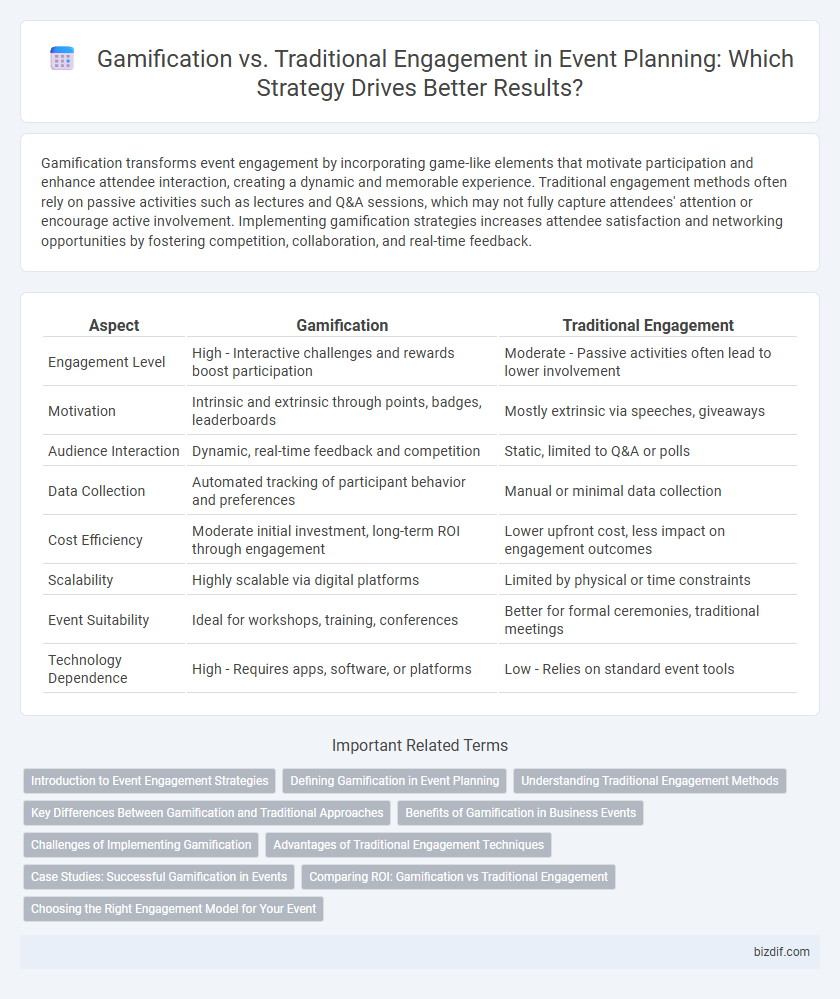Gamification transforms event engagement by incorporating game-like elements that motivate participation and enhance attendee interaction, creating a dynamic and memorable experience. Traditional engagement methods often rely on passive activities such as lectures and Q&A sessions, which may not fully capture attendees' attention or encourage active involvement. Implementing gamification strategies increases attendee satisfaction and networking opportunities by fostering competition, collaboration, and real-time feedback.
Table of Comparison
| Aspect | Gamification | Traditional Engagement |
|---|---|---|
| Engagement Level | High - Interactive challenges and rewards boost participation | Moderate - Passive activities often lead to lower involvement |
| Motivation | Intrinsic and extrinsic through points, badges, leaderboards | Mostly extrinsic via speeches, giveaways |
| Audience Interaction | Dynamic, real-time feedback and competition | Static, limited to Q&A or polls |
| Data Collection | Automated tracking of participant behavior and preferences | Manual or minimal data collection |
| Cost Efficiency | Moderate initial investment, long-term ROI through engagement | Lower upfront cost, less impact on engagement outcomes |
| Scalability | Highly scalable via digital platforms | Limited by physical or time constraints |
| Event Suitability | Ideal for workshops, training, conferences | Better for formal ceremonies, traditional meetings |
| Technology Dependence | High - Requires apps, software, or platforms | Low - Relies on standard event tools |
Introduction to Event Engagement Strategies
Gamification integrates game-like elements such as points, leaderboards, and challenges to boost participant interaction and excitement during events. Traditional engagement methods rely on lectures, panels, and Q&A sessions to maintain audience attention and involvement. Balancing gamification with conventional techniques creates dynamic event engagement strategies that enhance attendee experience and foster deeper connections.
Defining Gamification in Event Planning
Gamification in event planning refers to the strategic use of game design elements such as points, leaderboards, and challenges to enhance attendee participation and motivation. Unlike traditional engagement methods that rely on passive content delivery, gamification actively encourages interaction and competition, leading to higher retention and satisfaction. This approach leverages behavioral psychology to create immersive experiences that drive networking, learning, and overall event success.
Understanding Traditional Engagement Methods
Traditional engagement methods in event planning often rely on passive participation techniques such as keynote speeches, panel discussions, and Q&A sessions. These approaches prioritize direct communication and information delivery but may result in lower attendee interaction and retention rates. Understanding these conventional strategies helps event planners evaluate when to integrate more interactive elements like gamification to enhance engagement and overall event impact.
Key Differences Between Gamification and Traditional Approaches
Gamification integrates game mechanics such as points, badges, and leaderboards to enhance participant motivation, while traditional event engagement relies on passive activities like presentations and Q&A sessions. Gamification fosters interactive and immersive experiences that increase attendee participation and retention rates, contrasting with the typically lower engagement levels in conventional methods. Data shows gamified events can boost engagement by up to 60%, making them a dynamic alternative to traditional approaches in event planning.
Benefits of Gamification in Business Events
Gamification in business events drives higher attendee engagement by incorporating interactive elements such as point scoring, leaderboards, and rewards, which motivate participation and foster a competitive spirit. This approach enhances knowledge retention and networking opportunities by creating immersive experiences that traditional engagement methods like lectures or passive Q&A sessions often lack. Businesses leveraging gamification report increased attendee satisfaction and measurable ROI through real-time feedback and data analytics.
Challenges of Implementing Gamification
Implementing gamification in event planning presents challenges such as technological integration complexities, participant motivation variability, and the need for continuous content updates to maintain engagement. Traditional engagement methods often rely on proven formats, while gamification requires balancing game mechanics with event objectives to avoid alienating non-gamer attendees. Ensuring data privacy and managing the cost of gamification platforms also pose significant hurdles for event organizers.
Advantages of Traditional Engagement Techniques
Traditional engagement techniques in event planning foster deep personal connections and reliable interaction through face-to-face communication, enhancing trust and rapport between attendees and organizers. These methods often leverage proven formats such as networking sessions, roundtable discussions, and keynote speeches that cater to diverse learning and social preferences. Additionally, traditional techniques minimize technical barriers, ensuring inclusivity and accessibility for all participants.
Case Studies: Successful Gamification in Events
Case studies demonstrate that gamification significantly boosts attendee participation and satisfaction compared to traditional engagement methods, with events reporting up to a 40% increase in interaction rates. Notable examples include the Cisco Live conference, which integrated leaderboards and challenges to enhance networking, resulting in a 30% rise in social media activity. Event planners leveraging gamified elements such as point scoring, badges, and real-time competitions consistently achieve higher attendee retention and improved feedback scores.
Comparing ROI: Gamification vs Traditional Engagement
Gamification in event planning demonstrates significantly higher ROI compared to traditional engagement methods, driving increased attendee interaction and prolonged participation. Metrics indicate a 30-50% boost in real-time engagement and a 20-40% improvement in lead generation through gamified experiences, enhancing brand recall and customer loyalty. Traditional strategies often yield lower conversion rates, as they lack the immersive and motivational elements essential for sustaining active audience involvement.
Choosing the Right Engagement Model for Your Event
Selecting the right engagement model for your event hinges on understanding your audience's preferences and event objectives, with gamification offering interactive challenges and rewards that boost participant involvement and retention. Traditional engagement methods, such as keynote speeches and panel discussions, provide structured information delivery but may result in lower attendee interaction. Incorporating data-driven insights and feedback helps event planners balance gamification's dynamic appeal against the familiarity and simplicity of traditional formats to maximize engagement and event success.
Gamification vs Traditional engagement Infographic

 bizdif.com
bizdif.com